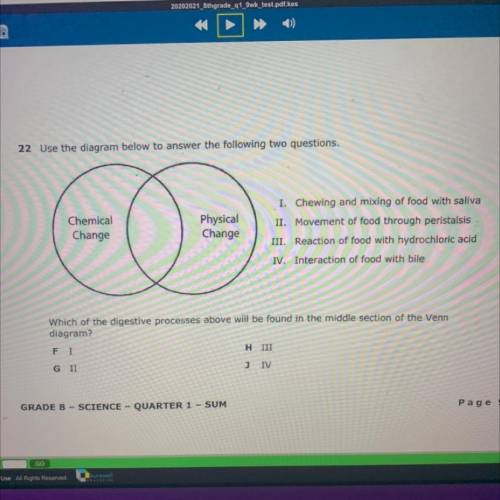22 Use the diagram below to answer the following two questions.
Chemical
Change
Physica...

Chemistry, 18.10.2020 07:01, Tristabergeron5650
22 Use the diagram below to answer the following two questions.
Chemical
Change
Physical
Change
I. Chewing and mixing of food with saliva
II. Movement of food through peristalsis
III. Reaction of food with hydrochloric acid
IV. Interaction of food with bile
Which of the digestive processes above will be found in the middle section of the Venn
diagram?
F I
H III
G II
) IV


Answers: 1
Other questions on the subject: Chemistry

Chemistry, 21.06.2019 16:30, KieraKimball
10-14. (a) when 100.0 ml of weak acid ha were titrated with 0.093 81 m naoh, 27.63 ml were required to reach the equivalence point. find the molarity of ha. (b) what is the formal concentration of a- at the equivalence point? (c) the ph at the equivalence point was 10.99. find pk. for ha. (d) what was the ph when only 19.47 ml of naoh had been added?
Answers: 1

Chemistry, 21.06.2019 23:00, fespinoza019
A100-watt light bulb radiates energy at a rate of 100 j/s. (the watt, a unit of power or energy over time, is defined as 1 j/s.) if all of the light emitted has a wavelength of 525 nm , how many photons are emitted per second?
Answers: 1


Chemistry, 22.06.2019 09:40, gonzaleze18
In the lab, ammonia was mixed with water to form ammonium hydroxide. what is/are the reactant(s)? o water and ammonia o ammonia o ammonium hydroxide need
Answers: 2
Do you know the correct answer?
Questions in other subjects:

Mathematics, 17.09.2019 19:00


Mathematics, 17.09.2019 19:00

Mathematics, 17.09.2019 19:00


Biology, 17.09.2019 19:00

Geography, 17.09.2019 19:00








